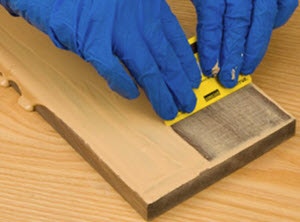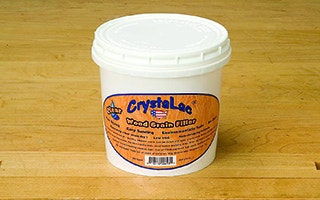The Secret To Mirror Like Finishes: Wood Grain Filler
Ever wonder how expert wood finishers get the mirror-like finish you find on examples of fine furniture? It isn't by hastily slapping on a coat or two of standard-issue polyurethane varnish. There are a number of steps involved, beginning with the way the piece is originally constructed on through several coats of clear finish and final hand-rubbing.
In between, there's the all important step of filling the wood grain pores to produce the perfectly flat surface that gives the final clear finish depth and a glass-smooth shine. Crystalac Clear Waterborne Wood Grain Filler makes the process about as easy as it can be. And in case you've never used wood grain filler, here are a few filler facts to help you see why.
Wood Grain Filler & Wood Putty Are Not The Same Thing
Wood grain filler is used strictly to fill wood grain pores and should not be confused with "wood putty". Wood putty (or wood filler) is a much thicker mixture, and is used to fill larger cracks and voids in the wood. Grain filler is a binder mixed with a filler material, such as silica, "micro balloons", clay, or calcium carbonate to for a thin paste. Most grain fillers are roughly the viscosity of pancake batter, making them easy to work into the grain of the wood, but still thick enough to span and fill the open pores of the grain.
Grain filler is most often used on “open- grained” woods like oak and mahogany. Open-grained woods have large open pores that are difficult to fill with clear finish, and cause the texture of the wood to show up on the finished surface of the wood. In terms of the strength and resilience of a finishing job, filling the grain is an optional step. If you like to see the texture of the wood telegraphed through the final coats of finish, then skip the grain filler; it won’t matter a bit in terms of the durability of the finish. But if you want to produce a glass smooth "piano" finish, especially on an open-grained species, grain filler would be pretty tough to do without.
Oil Based or Waterborne?
There are two main varieties of wood grain filler: Oil-based or waterborne. Oil-based filler is as old as oil-based finish itself, and has a dedicated following. Waterborne wood grain fillers are the new kids on the block, but are rapidly gaining favor because of the easy soap and water clean-up and greatly shortened drying time it offers. You might think that using a waterborne filler would limit you to using a waterborne finish, but that's not the case. A waterborne filler like Crystalac can be used under any clear finish, and is actually less finicky than an oil-based filler when it comes to accepting the final clear finish.
Wood Grain Filler Application
Application varies some from filler to filler, but in general, you trowel or brush the filler on, squeegee or wipe of the excess, wait for it to dry, and sand it level with the surface of the wood. Grain fillers are fairly easy to use, but one thing does take a little skill and thought: getting the color right. And getting it right the first time is important. Most wood grain fillers won"t take a stain very well after they dry; whatever color of filler you stuff into the grain of the wood will be a highly visible and permanent change.

Most grain fillers are either tinted to emulate the color of various woods, or come in an opaque "neutral" color. With an opaque filler, you’re almost guaranteed to need to do a little tweaking of the color to get the effect you want. Crystalac Clear Waterborne Wood Grain Filler, on the other hand, dries water-clear, which can be a real advantage: You don’t have to worry about getting the perfect color, nor do you have to worry about getting every last bit of the excess filler sanded off: If you leave a little behind, you’ll never see it.
Aesthetically, the color of the filler you use has a tremendous impact on the look of the wood . A clear grain filler on an open-grained wood has the effect of adding depth. If you want to experiment with colored filler effects, Crystalac takes any water or alcohol soluble tint.
Wood finishing is an art form, and the more you're at it, the more you see that it isn't an "after-thought". It's often the make-or-break point of a project, and can involve several steps. Adding wood grain filler to your finishing repertoire is a great way to bump your wood finishing results up to the next level. And fast, easy sanding, forgiving Crystalac lets you do it with exceptional results and virtually no learning curve.
Keep the inspiration coming!
Subscribe to our newsletter for more woodworking tips and tricks




